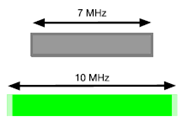Content for TR 38.844 Word version: 18.0.0
6 Result, Analysis outcome
6.1 Study of larger Channel BW than licensed BW
6.1.1 General Aspects
...
...
6 Result, Analysis outcome p. 10
6.1 Study of larger Channel BW than licensed BW p. 10
6.1.1 General Aspects p. 10
This clause describes, in general terms, how to utilize an irregular Channel Bandwidth by deploying the "larger channel Bandwidth" method.
The premise idea is that the system is configured with the larger channel bandwidth, as indicated in the broadcast System Information (SIB1) as described in clause 6.1.2.1, or UE is reconfigured to the larger channel bandwidth in connected mode than SIB1 as described in clause 6.1.2.2, but the actual number of scheduled RBs is restricted so that it matches actual spectrum allocation ensuring sufficiently large guard bands.

Figure 6.1.1-1: Using the next larger channel bandwidth (example for 7MHz)
(⇒ copy of original 3GPP image)
(⇒ copy of original 3GPP image)
One of the first aspects for this approach is the size of guard bands and the anticipated number of schedulable RBs. For the standard channel bandwidths, both values are captured in the corresponding specification to avoid any misinterpretation on how many RBs can be configured and scheduled. Following the same principle for every irregular channel bandwidth would be feasible, but would create the same amount of technical specification work as if the corresponding irregular channel bandwidth were explicitly added to the specifications. Thus, the number of "available" RBs can be calculated based on certain assumptions.
The maximum number of "available" or "schedulable" RBs for a particular irregular channel bandwidth can be calculated based on the assumption of using larger guard bands from a larger channel bandwidth. As an example, while considering the 7MHz channel bandwidth, the assumption is to consider next larger 10MHz channel guard bands at both ends, from which number of available RBs can be calculated.
Table 6.1.1-1 below presents example maximum number of available RBs for different irregular channel bandwidths considered in this study item.
| Channel (MHz) | Next larger channel (MHz) | Next larger channel guard band (kHz) | Next larger channel Nrb | Channel Nrb | Utilisation (%) |
|---|---|---|---|---|---|
| 6 | 10 | 312,5 | 52 | 29 | 87 |
| 7 | 10 | 312,5 | 52 | 35 | 90 |
| 11 | 15 | 382,5 | 79 | 56 | 91,6 |
| 12 | 15 | 382,5 | 79 | 62 | 93 |
| 13 | 15 | 382,5 | 79 | 67 | 92,8 |
Table 6.1.1-2 below presents similar calculations for 30kHz SCS, from which one can see that combination of 30kHz SCS and the next larger channel is not generally a good approach for small channel bandwidths. The main reason is that 30kHz SCS has much larger guard bands, which immediately impacts number of available RBs. As a small summary, assuming using guard band from the next larger channel the resulting spectrum Utilization would range from 87 to 92.8% for an SCS of 15kHz and 72 to 88.6% for an SCS of 30kHz.
| Channel (MHz) | Next larger channel (MHz) | Next larger channel guard band (kHz) | Next larger channel Nrb | Channel Nrb | Utilisation (%) |
|---|---|---|---|---|---|
| 6 | 10 | 665 | 24 | 12 | 72 |
| 7 | 10 | 665 | 24 | 15 | 77,1 |
| 11 | 15 | 645 | 38 | 26 | 85,1 |
| 12 | 15 | 645 | 38 | 29 | 87 |
| 13 | 15 | 645 | 38 | 32 | 88,6 |